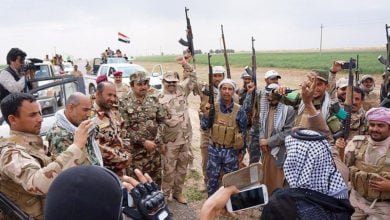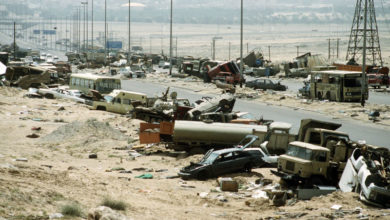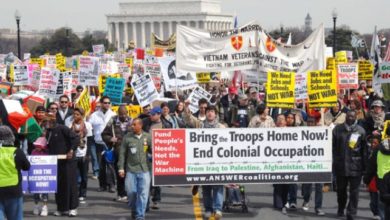 The Iraqi resistance controls Fallujah. Photo: Akram Saleh/Reuters |
The Iraq war and occupation has turned into the biggest U.S. foreign policy crisis in decades. As Bush administration strategic planners are well aware, it has the potential to both trigger a renewed mass outpouring of antiwar sentiment in the U.S. and bring down the administration.
The White House and Pentagon are struggling to keep the situation under control, at least until Election Day has passed. Achieving that objective, they are acutely aware, is dependent on preventing a sharp rise in U.S. combat casualties.
It’s not that the strategists care about those who are dying. It is instead the knowledge that a spike in casualties would be particularly hazardous at a time when popular opposition to the war is growing. More and more family members of soldiers killed in Iraq are speaking out against what is widely seen as an unjustified war.
Washington’s Iraq strategy today is a mix designed to fulfill both domestic political goals and the overriding determination to retain Iraq as a permanent neo-colony. The real source of the U.S. policy makers’ problem is the unanticipated strength of the Iraqi popular resistance to occupation, which by all accounts is continuing to grow in numbers and organization.
On average, according to the Pentagon, two to three U.S. soldiers are being killed daily in Iraq. But the reliability of these numbers is questionable. In August, for instance, more than 1,100 U.S. troops were reported wounded, with 60 listed as killed. That is a huge discrepancy between fatal and non-fatal combat casualties, out of line with earlier monthly reports. The Pentagon has reported a total of 1,019 U.S. soldiers killed and 7,245 wounded in Iraq as of Sept. 15, 2004. According to the U.S. Transportation Command, an additional 16,765 military personnel have been evacuated from Iraq and Afghanistan for injuries or ailments “not directly related to combat.” There is no report of how many of the evacuated soldiers died. (UPI, Sept. 15, 2004)
At the same time, Iraqi casualties have soared. It is estimated that at least 30,000 Iraqi civilians have been killed, and tens of thousands more wounded since the March 2003 invasion. The U.S. has repeatedly unleashed such fearsome weapons of mass destruction as the AC-130 gunship on heavily populated areas. The AC-130 fires 1,800 heavy machine gun bullets per minute, often using depleted uranium ammunition.
Administration spokespersons and their corporate media mouthpieces routinely and in a racist fashion downplay or ignore Iraqi casualties.
Avoiding a dramatic rise in U.S. battle deaths has been a major factor in the Pentagon’s strategy with regard to the cities of central and western Iraq that are no longer under occupation control, including Ramadi, Baquba, Fallujah, parts of Baghdad, and others.
The loss of control over these cities was highlighted in the lead story in the Sept. 8, 2004, New York Times. “U.S. Conceding Rebels Control Regions of Iraq,” read the headline.
The article, published on the same day that the official U.S. death toll in Iraq passed 1,000, makes clear that an all-out assault on the cities-the only way that the occupation forces could regain control-would entail heavy losses. The three-week siege of Fallujah in April killed more than 600 Iraqis and scores of U.S. troops, before the occupation forces pulled back to heavily fortified positions outside the city.
It was only by pulling out of the central Iraqi cities and sharply curtailing patrols that the Pentagon commanders were able to limit combat losses. But in the process, the occupation gained space and grew stronger, now able to operate and organize more openly in many of the largest cities.
The growing strength of the resistance is reflected in the rise in attacks on U.S. forces, from around 700 in March of this year to more than 2,700 in August, according to “Multinational Force-Iraq,” the new name the occupiers have given themselves. (NYT, Sept. 8, 2004)
Thus the dilemma: If the U.S. military attacks the growing Iraqi resistance head on, casualties on both sides will soar and so, too, will antiwar sentiment in the U.S. and around the world. If the occupiers pull back, the resistance grows even stronger in preparation for battles to come.
And there is no doubt that more major battles are coming. U.S. leaders-whether their names are Bush or Kerry, McCain or Kennedy-have no intention of surrendering their oil-rich war prize. Leaving Iraq would be an enormous blow to U.S. imperialism, and give a tremendous impetus to all those struggling for liberation in the Middle East and around the world.
Two elections and U.S. strategy
The U.S. presidential election will take place on Nov. 2. An election in occupied Iraq is scheduled by the end of January 2005.
The Iraq interim government headed by long-time CIA agent and now “prime minister,” Iyad Allawi, has virtually no credibility inside Iraq. He is almost universally perceived as a puppet. The real top official in the country, as is widely understood, is the U.S. ambassador, John Negroponte, who rarely ventures out of his fortress headquarters in the capital.
 Boots of one of the first U.S. casualties in Iraq, Marine Corps Cpl. Jesús A. Suárez del Solar, in a symbolic display during the Republican National Convention in New York City. Photo: Bill Hackwell |
The January 2005 election in Iraq has zero chance of being viewed as credible if many of the major cities remain under the control of the resistance. The elections, viewed as just another phase of the colonial occupation by the resistance, would not take place in those cities.
Washington is determined to have the election as a next step to consolidate U.S. control with an Iraqi face. The Bush administration’s preference is to delay major ground operations until after Nov. 2, win the election, then carry out a massive offensive to re-subjugate the liberated cities of Iraq before the January election.
Given the rapid growth in strength and operational capacity of the Iraqi resistance, it is not clear that U.S. commanders and their bosses will feel compelled to stick to that timetable. When push comes to shove, their top priority is retaining control of Iraq.
In the meantime, the occupation forces have been using airpower, including fighter-bombers and attack helicopters, as well as long-range artillery, to pound resistance-controlled areas, especially Fallujah, a city of more than 500,000 people. Doctors in Fallujah have reported that hospitals there are overwhelmed with civilian casualties.
It is a war of terror against the resisting Iraqi people, just as it has been since the beginning. The antiwar and people’s movements, inside the U.S. and around the world, need to intensify our mobilizations to end the occupation and the war, regardless of who wins the White House in November.





